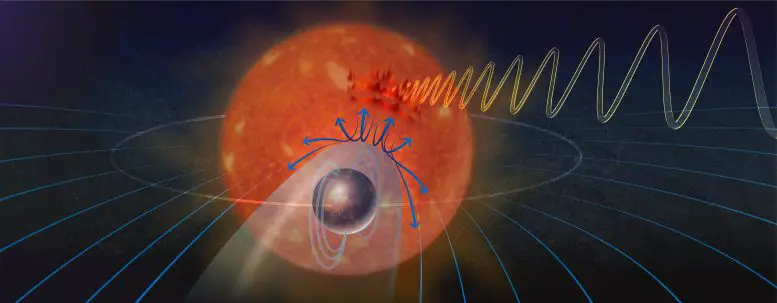Radio emissions from about 12 light-years outside our solar system reveal a possible magnetic interaction between the star YZ Cita and its suspected rocky planet in close orbit.
Researchers have detected radio emissions from the star YZ Ceti, suggesting the presence of a magnetic field in its rocky Earth-size exoplanet YZ Ceti b. Sebastian Pineda and Jackie Willadsen observed repetitive radio signals using the Carl G. Jansky Very Large Array and suggested that they are produced by magnetic interaction between a star and a planet orbiting it. This research offers a promising method for detecting magnetic fields on other Earth-like exoplanets that are critical to maintaining atmospheres and supporting life.
Earth’s magnetic field does more than point compass needles in the same direction. It also helps preserve some of Earth’s vital atmosphere by deflecting the high-energy particles and plasma that are regularly expelled from the Sun. Now researchers have identified a promising Earth-sized planet in another solar system as a prime candidate for the magnetic field – YZ Ceti b, a rocky planet orbiting a star about 12 light-years from Earth.
Using the Carl G. Jansky Very Large Array, a radio telescope at the US National Science Foundation’s National Radio Astronomy Observatory (NRAO), researchers Sebastian Pineda and Jackie Willadsen observed the repetitive radio signal emanating from the star YZ Ceti. Pineda and Willadsen’s research to understand magnetic field interactions between distant stars and planets orbiting them is supported by NSF. Their research was published today (April 3, 2023) in the journal. Nature Astronomy.
“Studying potentially habitable or habitable worlds in other solar systems depends in part on our ability to determine whether rocky, Earth-like exoplanets do indeed have magnetic fields,” says Joe Pesce, program director of the NSF’s National Radio Astronomy Observatory. “This study not only shows that this particular rocky exoplanet likely has a magnetic field, but also provides a promising method for finding new ones.”
Pineda, an astrophysicist at the University of Colorado, explains that a planet’s magnetic field can prevent that planet’s atmosphere from being eroded over time by particles ejected from its star. “Whether a planet with an atmosphere can survive depends on whether the planet has a strong magnetic field.”
A radio signal from another star
“I see things that no one has seen before,” recalls Willadsen, an astronomer at Bucknell University, when he first picked up the radio signal while streaming data at his home over the weekend. “We saw the first surge and it looked great,” Pineda says. “When we saw it again, it made a lot of sense, okay, maybe we really have something here.”
The researchers hypothesize that the stellar radio waves they detected were produced by the interaction between the exoplanet’s magnetic field and its orbiting star. However, such radio waves must be very strong to be detected at great distances. While magnetic fields have been detected on huge Jupiter-sized exoplanets before, a relatively small Earth-size exoplanet requires a different technique.
Willadsen explains that because magnetic fields are invisible, it’s hard to tell if they’re actually on a distant planet. “We’re looking for a way to see them,” he says. “We’re looking for planets that are very close to their star and similar in size to Earth. These planets are too close to their star to be habitable, but because they’re so close, the planet seems to blow up a lot of things moving away from the star.













